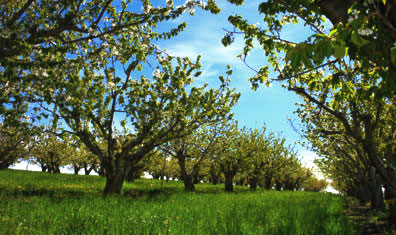High on a windswept hill, hundreds of apple saplings settle into high-tech homes at Washington State University’s Spillman Agronomy Farm. After a century of being forced from one location to the next, the heirloom trees may have finally found a permanent site two miles south of the Pullman campus.
“We don’t anticipate any urban, residential, or university development taking place out here,” says Rich Koenig, professor in crop and soil sciences. “Our vision is that the orchard will be part of the new Tukey Horticultural Center for research, teaching, and extension outreach.
“It won’t be just tree fruit,” he says. “Eventually, we want to include landscape plants, ornamental horticulture, berries, vegetables, and opportunities for education and future research. You don’t often get this chance to build from the ground up, to design a facility that uses all the modern technologies.”
Horticulture has been at the heart of the University’s mission since its inception in 1890. Remnants of the earliest apple orchard—planted in 1902 near the current Lewis Alumni Centre—can still be found in flower beds by Hulbert Hall.

Formal orchard teaching facilities were constructed in 1968 along Fairway Lane where the Student Recreation Center now stands. As WSU continued to grow, the grove was moved to an area near the Moscow-Pullman Regional Airport and named for Extension orchardist Ronald B. Tukey. There, Tukey Orchard thrived for 40 years along with its popular public fruit sales.
In 2015, airport officials threw a wrench into the works when they proposed an expansion and realignment of the runway to accommodate larger aircraft. Plans for the new 1.3-mile runway involved purchasing half of the 70-acre orchard and placing restrictions on the part that remained.
“The FAA had the authority to restrict orchard operations if any activities near the runway created hazards for airplanes,” Koenig says. “For example, things that attract birds, like cherry trees. Or students walking in the runway protection zone—that area where, if a plane is going to go down, it has a high probability of doing so during takeoff or landing.”
With limited options elsewhere on campus, Koenig says they began the monumental task of moving Tukey Orchard’s 120 heirloom apple varieties and other fruit trees to a ten-acre tract at Spillman Farm. Much of the work fell to the cheerful expertise of farm manager Deb Pehrson.
“We’re not moving any trees to the new site, just grafting cuttings onto new root stocks,” she says. “We have to start over fresh.”
As the tree fruit industry moves toward automated harvesting, that means planting dwarf trees which require the support of trellises. Dwarf trees also allow for closer planting—up to 1,000 trees per acre at the Spillman site.
Pehrson says branches from their old apple varieties, like Winesap, Jonathan, and Scarlet O’Hara, were grafted onto dwarf root stocks and placed in potting soil to “take” for a year or more. Some waited in pots for three years while trellises and irrigation systems were installed and environmental hurdles navigated. Meanwhile, a few trees at the old site remain in place until a new crop can be harvested at Spillman Farm.
“You never want to totally give up the old stuff,” Koenig says. “There’s value in the diversity of the genetic material. You might discover a unique characteristic, color, or flavor and want to use it for breeding material sometime in the future. There may be disease resistance in one of these old varieties that we didn’t even know about.”
Pehrson, who is helping design the orchard layout, says they will be planting lots of new stuff as well. “I want to try growing different things that students don’t usually see, like kiwis or maybe nut trees and mulberries in the windbreaks.”
“When the orchard was originally planted at WSC, the vast majority of tree fruit faculty were here on campus,” says Koenig. “Today, most are located out at the research centers, but there is still a relevant piece here in Pullman focused on genetics and genomics rather than fruit production per acre. The orchard is still an important asset to the department, faculty, and students.”
“As a land-grant university, the orchard is also a good way to develop community relations,” adds Pehrson. “People really appreciate having an outdoor space they can go to purchase locally grown fruit.”
Web extra
This fall, public apple sales will once again be offered at Tukey Horticultural Center.
